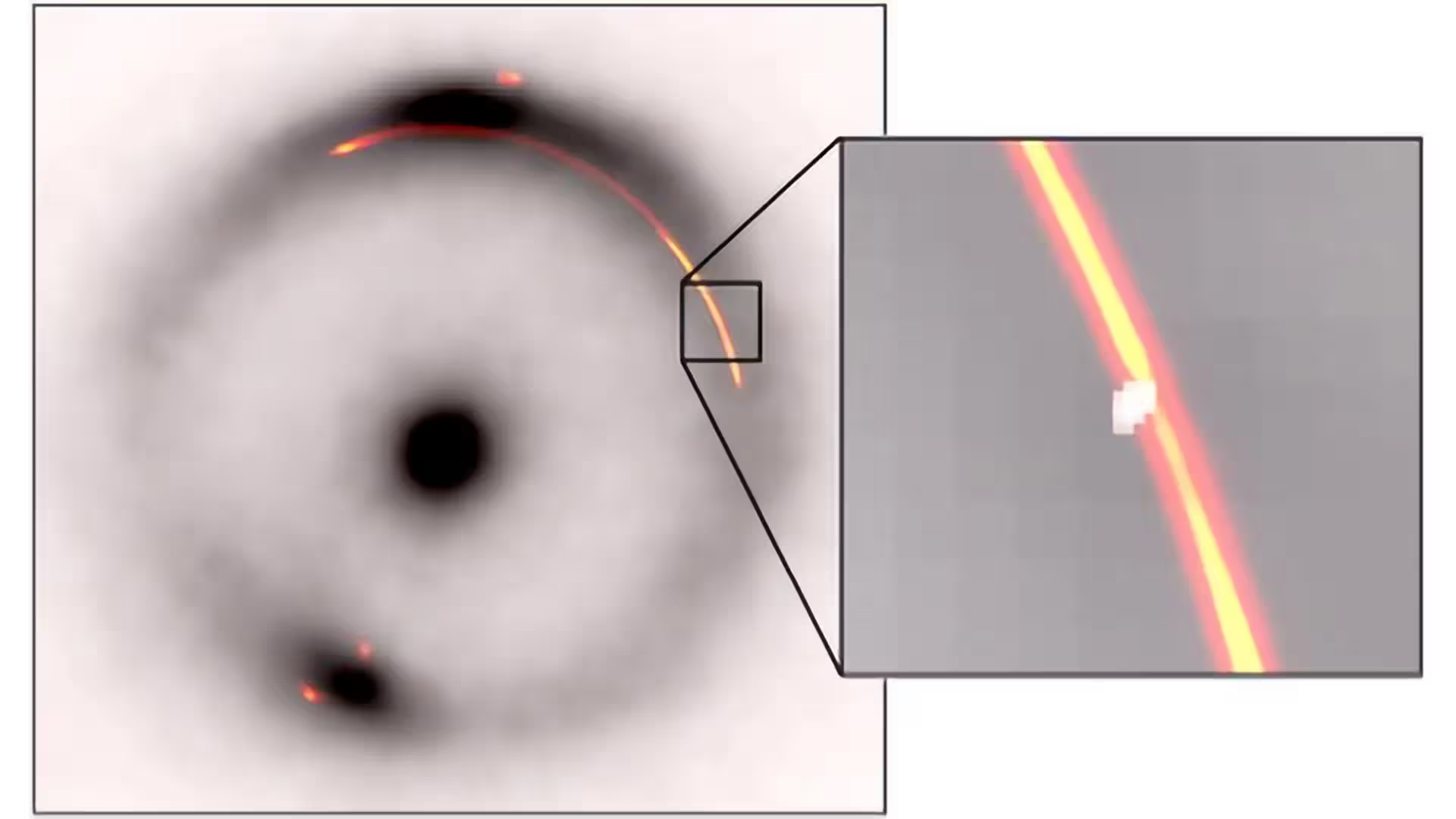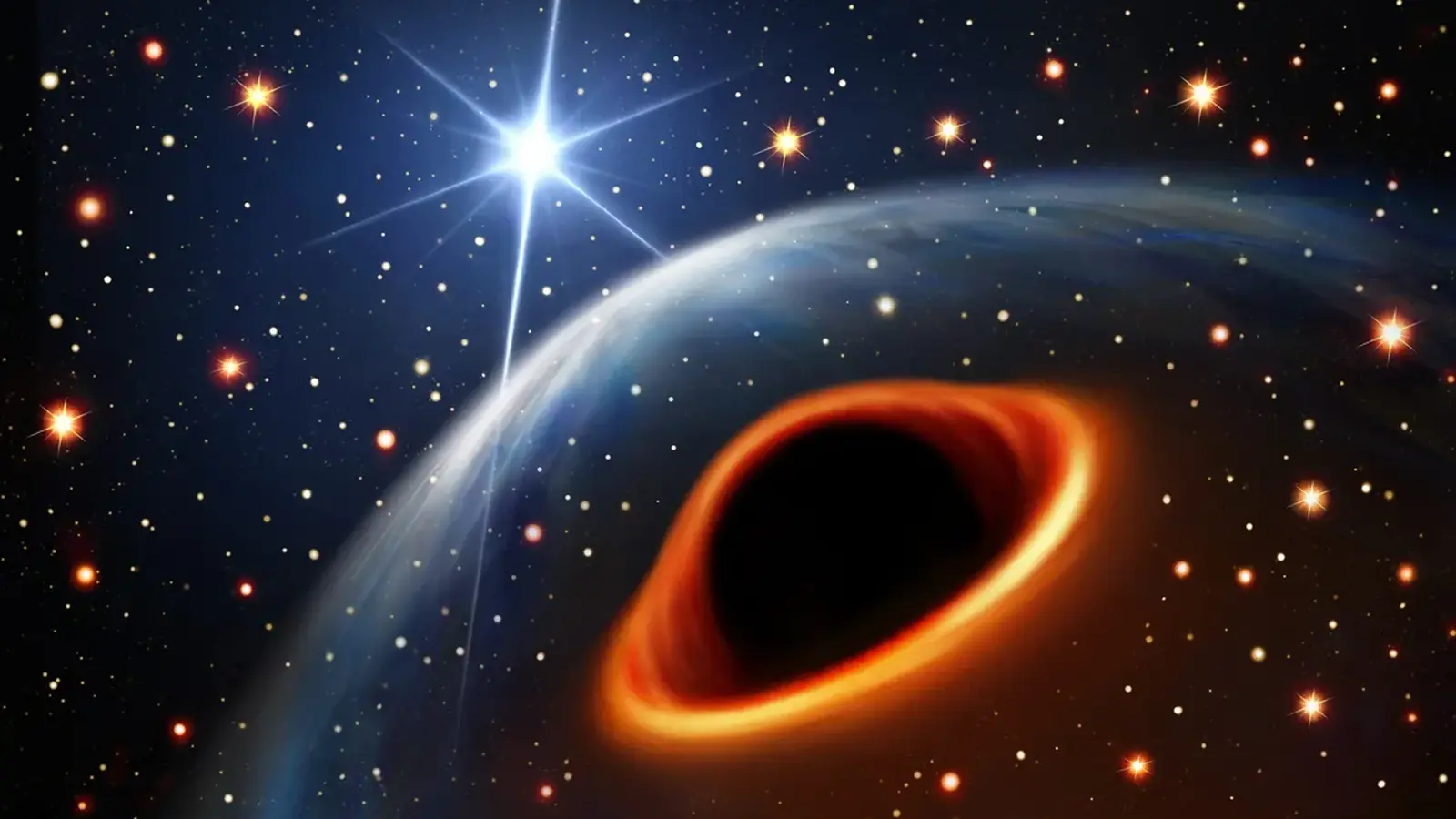6 Minutes
Discovery: the smallest dark gravitational lens yet found
A multinational team of astronomers has identified the lowest-mass dark object ever detected through gravitational lensing. Using a global network of radio telescopes, researchers observed a subtle distortion — a tiny "pinch" — in the lensed image of a distant galaxy. From that distortion they inferred an unseen mass of roughly one million times the mass of the Sun. The result was published in two papers on Oct. 9 in Nature Astronomy and the Monthly Notices of the Royal Astronomical Society.
Because the object emits no detectable light or radiation, astronomers located it by studying how it altered the path of light from a background galaxy. Gravitational lensing occurs when mass bends spacetime and deflects light; by precisely modeling the lensing pattern, scientists can estimate the mass, size and location of invisible structures.

The black ring and central dot show infrared image of a distant galaxy distorted by a gravitation lens. Orange/reg shows radio waves from the same object. The inset shows a pinch caused by another, much smaller, dark gravitational lens (white blob).
"It's an impressive achievement to detect such a low mass object at such a large distance from us," said Chris Fassnacht, professor in the Department of Physics and Astronomy at the University of California, Davis, and a co-author on one of the papers. "Finding low-mass objects such as this one is critical for learning about the nature of dark matter."
How the observation was made
The team combined high-resolution radio data from several major facilities to act as an Earth-sized interferometer. Key instruments included the Green Bank Telescope (GBT) in West Virginia, the Very Long Baseline Array (VLBA) in Hawaiʻi, and the European VLBI Network (EVN), which links radio dishes across Europe, Asia, South Africa and Puerto Rico. By correlating signals across these telescopes, the astronomers achieved the angular resolution necessary to detect minute anomalies in the lensed images.
Gravitational lensing as a probe of invisible mass
When a massive foreground galaxy or cluster lenses a more distant source, it typically creates arcs, rings or multiple images. Small, compact masses along the light path — whether dark matter clumps or tiny galaxies — impose additional, localized changes in the magnification and shape of those images. The newly reported object manifested only as a localized "pinch" in the lensed radio emission, indicating a very compact mass that would otherwise be undetectable.
Nature and implications of the million-solar-mass object
The mass inferred from the lensing anomaly is about 1 x 10^6 solar masses. That scale sits between typical globular clusters and small dwarf galaxies. Two leading interpretations are under consideration:
- A compact dark matter subhalo — a dense clump of dark matter with little or no stars. Detecting such clumps would support predictions from cold dark matter (CDM) models that structure forms hierarchically, down to very low masses.
- An ultra-compact, dormant dwarf galaxy that contains few or no active stars and therefore remains essentially invisible at optical wavelengths.
Lead author Devon Powell of the Max Planck Institute for Astrophysics noted, "Given the sensitivity of our data, we were expecting to find at least one dark object, so our discovery is consistent with the so-called 'cold dark matter theory' on which much of our understanding of how galaxies form is based. Having found one, the question now is whether we can find more and whether the numbers will still agree with the models."
Finding starless dark matter clumps would place strong constraints on alternative dark matter models (for example, warm or self-interacting dark matter) that suppress the formation of small-scale structure. Conversely, if many such objects turn out to be faint galaxies rather than pure dark-matter subhalos, that will change census estimates for low-mass, low-luminosity galaxies across cosmic history.
Team, methods and future searches
The analysis combined precise lens modeling with very long baseline interferometry techniques. Other contributors include John McKean (University of Groningen, South African Radio Observatory and University of Pretoria), Simona Vegetti (Max Planck Institute for Astrophysics), Cristiana Spingola (Istituto di Radioastronomia, Bologna) and Simon D. M. White (Max Planck Institute for Astrophysics). Funding and institutional support came from the European Research Council, the Italian Ministry of Foreign Affairs and International Cooperation, the National Research Foundation of South Africa, and facilities such as the National Radio Astronomy Observatory.
Armed with this method, researchers plan to search additional strong-lens systems to measure the abundance and mass distribution of similar compact objects. If a statistical sample grows, scientists can compare observed counts with theoretical predictions and either reinforce or challenge prevailing dark matter paradigms.
Expert Insight
Dr. Amina Torres, an observational cosmologist at the Institute for Theoretical Astrophysics (fictional comment), commented: "This detection demonstrates the power of combining global radio arrays with careful lens modeling. Whether the object is a pure dark subhalo or an almost dark dwarf galaxy, each detection informs the small-scale structure of the Universe. Repeating this analysis across many lenses will be decisive for testing competing dark matter theories."
Conclusion
The detection of a million-sun-mass, optically invisible object marks a milestone in using gravitational lensing to probe the dark components of the cosmos. By leveraging Earth-sized interferometric baselines and precision lens models, astronomers are now able to detect and begin to characterize compact masses at scales an order of magnitude smaller than previously possible. Continued surveys and follow-up observations will determine whether this object is a dark matter clump or an ultra-compact dwarf galaxy — and whether many more such hidden structures sculpt the visible Universe.
Additional work is ongoing to refine the lens models, probe the object's environment, and search for analogous features in other lensed systems. These efforts will help clarify how dark matter organizes itself on the smallest cosmic scales and how that organization influenced galaxy formation over the history of the Universe.
Source: sciencedaily


Leave a Comment